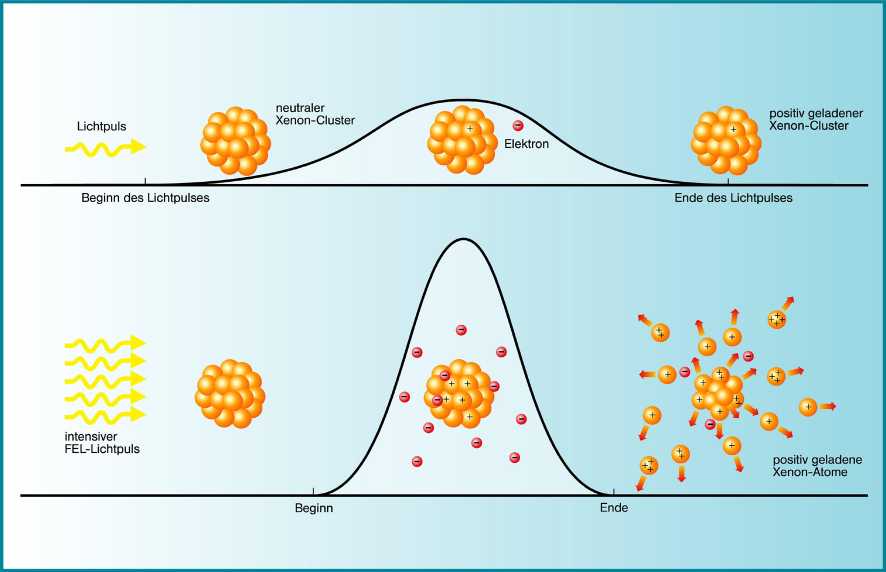We all learned in high school science classes about three states of matter: solid, liquid, and gaseous. Liquids were described as the bridge between gases and solids, possessing a definite volume but no definite shape, compared to gases which have neither, and solids which have both. Those who continued on in science learned about a fourth and -- from a universal perspective -- more common form of matter called plasma, which is an ionized gas.
In recent times, scientists have added to this list yet another form of matter -- aggregates of atoms packed into spherically shaped objects called "clusters." Numbering as few as three or as many as a million individual atoms in size, these tiny bits of matter serve as a bridge between gases and bulk phase materials (liquids and solids), and if you visit the chemistry, physics, or materials sciences departments of any major research institution today, you are almost certain to find someone who is working with them.
 http://www.britannica.com/EBchecked/topic/122615/cluster
http://www.britannica.com/EBchecked/topic/122615/clusterClusters can be formed from any element on the periodic chart. They can be composed of a single type of atom -- an "elemental cluster" -- or they can be composed of two or more different types of atoms or molecules. Depending on their composition, they can be metallic or non-metallic. There are electrically neutral clusters, and there are electrically-charged "ionic" clusters.
What all clusters have in common, however, is their in-between size: they are too large to be thought of as a molecule but too small to be classified as a liquid or a solid. Consequently, clusters frequently exhibit physical and chemical properties not seen in bulk phase materials -- properties that scientists hope to exploit in a broad number of areas.
For chemists, an area considered by many to be a holy grail is the study of matter as it evolves from the gas to the liquid state. New knowledge about this transition is expected to come from a better understanding of the formation and structure of ionic clusters.
Ionic clusters consist of a single ion surrounded by one or more neutral molecules. They are created when a gas is cooled. Molecules in the gaseous state are widely separated and move about in continual motion. So widely separated in space are these molecules that they exert no force of attraction upon one another, and although they frequently collide, their kinetic energy is so high they will not stick together. These gas molecules must be cooled to reduce their kinetic energy and associated random motion.
As the temperature in the gas drops, however, molecular motion slows and the molecules begin to gather and stick together. Eventually, the motion slows sufficiently for intermolecular forces of attraction to bind the molecules together into clusters that number from a few to a few hundred individual molecules in size. If the number of neutral molecules surrounding the ion in each cluster becomes sufficiently large, an assemblage of clusters will resemble a conventional bulk material--either a liquid or a solid.
Three common ways exist to produce clusters:
a) - Gas aggregation sources: This is the oldest and easiest method for cluster production. Atoms or molecules are evaporated into a flow of rare gas atoms. The evaporated atoms are cooled in collision with the rare gas. When the atoms or molecules loose enough energy the cluster production is started.
It is possible that this cooling process may be going on in the Papp gas mix as some of the noble gases is cooling another one of the noble gases through collision; a sort of moderation.
b) - Laser-ablation sources (surface sources, sputtering): Photon or heavy particle impact on a surface leads to the desorption of atoms or molecules. The released atoms or molecules are partially ionized and form plasma. Similar like in the gas aggregation sources the plasma is cooled by present rare gas and cluster formation is achieved
c) - Supersonic cluster sources: A gas under high pressure is expanded adiabatically through a small nozzle. This is how noble gases are liquefied.
Could noble gases form clusters when they are introduced from the syringe into the vacuum of the cylinder?

To enhance the clustering effect, a cylinder/piston design might be engineered to perform this function by reconditioning the noble gases by driving them through a supersonic nozzle into a vacuum as part of the firing cycle. Or a turboexpander might be used to condition and cool the noble gases.
http://en.wikipedia.org/wiki/Turboexpander




